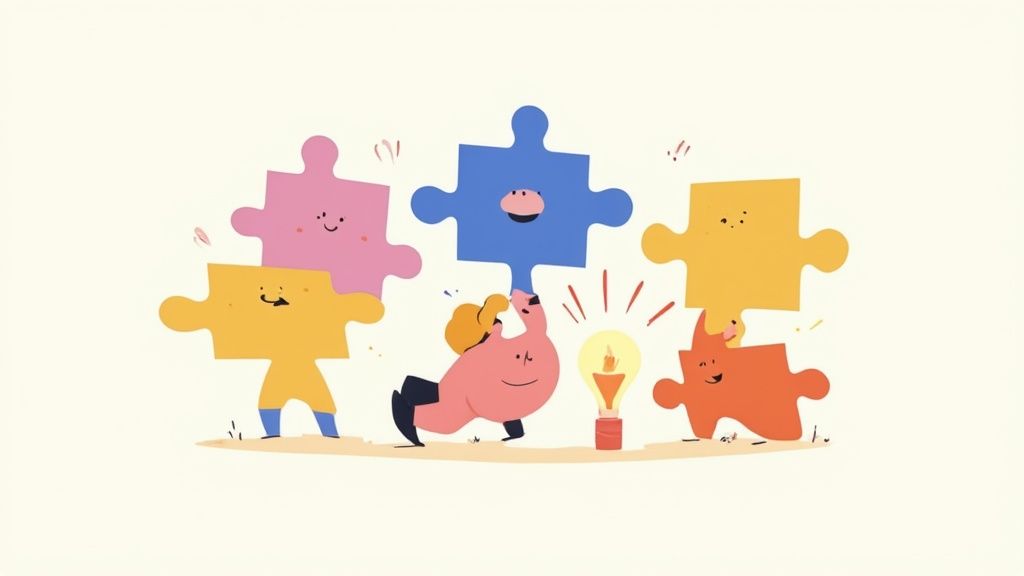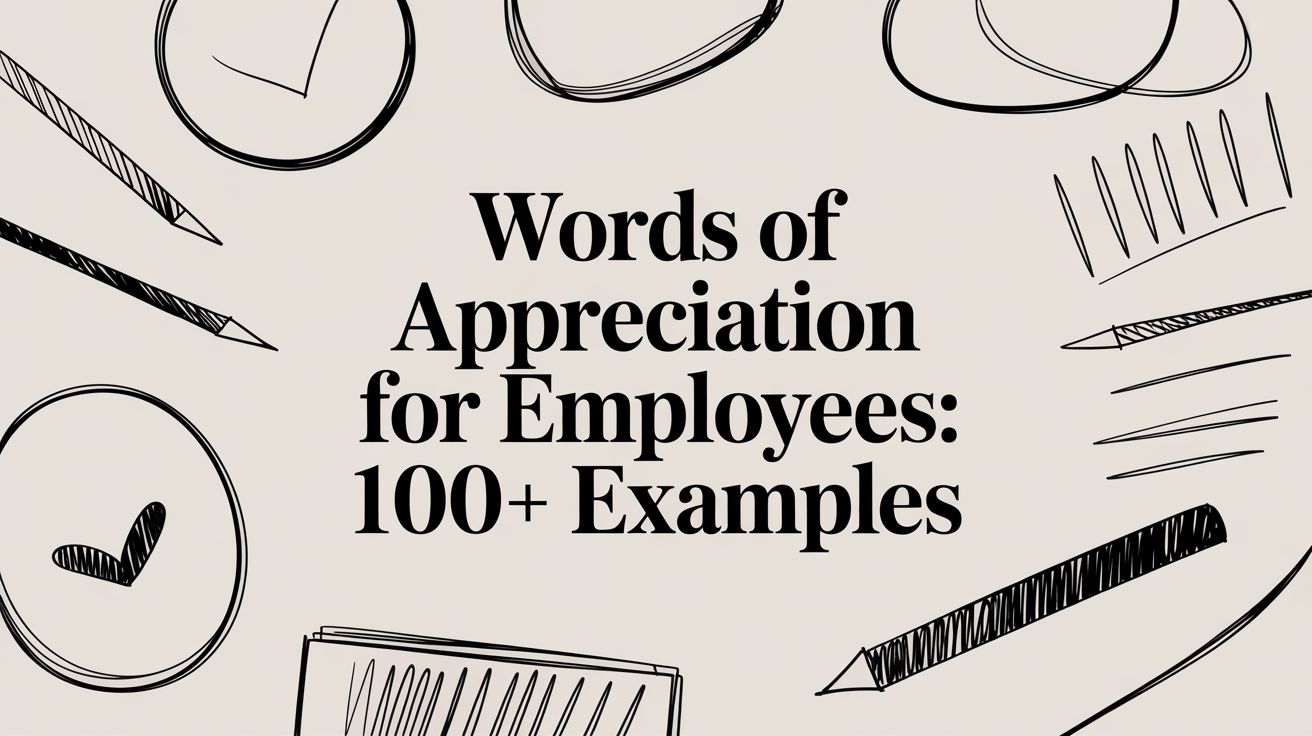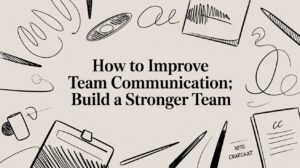In today's competitive landscape, employee recognition is no longer a soft skill—it's a strategic imperative. The right words of appreciation for employees can dramatically boost morale, engagement, and retention. However, generic praise like a quick "good job" often falls flat, feeling impersonal and obligatory. Your top performers can tell the difference between a genuine acknowledgment and a checkbox exercise, and that difference directly impacts their motivation and loyalty.
Table of Contents
This comprehensive guide moves beyond the basics. We're not just giving you a list of phrases; we're breaking down the psychology of effective recognition. You will learn why specific, timely, and meaningful praise is the ultimate competitive advantage for modern teams. We will explore eight distinct categories of appreciation, providing over 100 actionable examples and templates that you can adapt and use immediately within your own workflows. More importantly, we'll explain the 'why' behind each type, helping you tailor your messages for maximum impact.
From acknowledging specific project wins and celebrating resilience after a tough quarter to praising quiet collaborators who make everything run smoothly, you'll learn how to craft recognition that makes your team feel genuinely seen and valued. To truly understand what motivates your team and drives performance, delve into the impact of personalized messages on employee morale and productivity. This guide will equip you with the specific language needed to foster a thriving workplace culture. We’ll also touch on how tools like AsanteBot can help you systematize these practices, turning good intentions into consistent, culture-building habits right within Slack.
1. Recognition of Specific Contributions
Vague praise like "good job" feels nice, but it lacks the weight and memorability of targeted acknowledgment. The most effective words of appreciation for employees are those that pinpoint a specific action, behavior, or accomplishment. This approach moves beyond generic compliments to show you are genuinely paying attention to individual efforts and their direct impact on the team and company.
Research from Gallup and workplace experts like Marcus Buckingham consistently highlights specificity as a cornerstone of effective employee engagement. When an employee understands exactly what they did well and why it mattered, the recognition becomes a powerful tool for reinforcing positive behaviors and encouraging future high performance. It validates their hard work and clarifies what success looks like within their role.
Why It Works
Specific recognition is powerful because it is credible and educational. It proves that a manager or peer has observed their work closely, making the praise feel earned and authentic. It also creates a clear blueprint for what the company values, guiding the recognized employee and their colleagues on how to contribute effectively.
For example, acknowledging a team's successful project launch by highlighting individual contributions shows that every member's role was vital. A practical example would be saying, "Great launch, team! Special thanks to Sarah for her meticulous QA testing that caught that critical bug, and to Tom for staying late to deploy the final build. Your combined efforts made this a smooth release." This fosters a sense of shared accomplishment and reinforces collaborative values, which is crucial for building a strong team culture.
How to Implement It Effectively
To make your appreciation specific and impactful, follow these steps:
- Be Timely: Deliver recognition as soon as possible after the achievement. A quick, specific message in a Slack channel celebrating a milestone reached that day is far more effective than a generic mention in a monthly meeting.
- Detail the Action: Clearly state what the employee did. Instead of "Thanks for your help," try "Thank you for staying late to help me troubleshoot that server issue."
- Explain the Impact: Connect their action to a positive outcome. Build on the previous example: "Because of your help, we were able to deploy the update on schedule and prevent any client disruption."
- Keep a Record: Use a simple document or a tool like AsanteBot to track notable contributions. This makes it easier to recall specifics during performance reviews or when nominating someone for an award.
Example Phrases:
- "Your detailed analysis in the Q3 marketing report was exceptional. It directly influenced our decision to pivot our strategy, which has already shown positive early results."
- "The way you mentored the new intern, Alex, has been incredible. Your guidance accelerated their onboarding and they're already contributing to team projects."
- "The client presentation you delivered last week was polished and professional. You represented our company perfectly and the client was very impressed."
By focusing on concrete contributions, you transform simple praise into a meaningful and motivating experience. You can discover more strategies in our guide to effective recognition and rewards programs.
2. Growth and Development Acknowledgment
Praising an outcome is effective, but acknowledging the journey of growth is deeply personal and motivating. The best words of appreciation for employees often highlight their professional development, skill acquisition, and expanding capabilities. This type of recognition signals that you see them not just for what they do today, but for who they are becoming. It shows you are invested in their long-term career path, which is a powerful driver of loyalty and engagement.
Insights from platforms like LinkedIn Learning and research by firms such as Deloitte emphasize that opportunities for development are a top priority for modern employees. When managers actively notice and praise an employee's progress, it validates their effort in learning new things and encourages a continuous improvement mindset. This fosters a culture where personal growth is celebrated as a collective win for the entire team.
Why It Works
Acknowledging growth is powerful because it's forward-looking and affirming. It tells employees that their efforts to learn and improve are not only seen but valued. This builds their confidence, encourages them to take on new challenges, and reinforces the idea that the company is a place where they can build a career, not just hold a job.
Recognizing development also strengthens the manager-employee relationship. It shifts the dynamic from purely transactional to a more supportive, mentor-like partnership. This is crucial for retaining top talent who are motivated by more than just salary.
How to Implement It Effectively
To make your appreciation for growth meaningful, follow these guidelines:
- Be Specific About the Skill: Pinpoint the exact area of improvement. Instead of "You're getting better," say "The way you've mastered Python for data analysis is truly impressive."
- Connect Growth to Impact: Show how their new skills are benefiting the team or company. For example, "Your new certification in project management has already made our team sprints more organized and efficient."
- Encourage Future Goals: Frame your recognition as a stepping stone. Ask about their next development goals and offer support, which shows genuine investment in their future.
- Celebrate Milestones: Acknowledge completed courses, certifications, or the first successful application of a new skill. When an employee achieves a significant career milestone like a promotion, visual recognition can amplify your message. You can find many inspiring congratulations images for promotions to share publicly.
Example Phrases:
- "I've watched your presentation skills evolve this past year. The confidence and clarity you showed in today's client call was outstanding."
- "Your commitment to learning our new CRM system has been a huge help to the entire team. Thank you for taking the initiative to become our go-to expert."
- "The way you handled that difficult negotiation demonstrates how much you've grown in your leadership abilities. It was a fantastic outcome for the company."
By focusing on an employee's developmental journey, you cultivate a resilient and ambitious team. For more inspiration, you can explore our guide to giving effective positive feedback for employees.
3. Team Contribution and Collaboration Praise
While individual achievements are vital, celebrating an employee's ability to elevate the entire team is equally important. Praising collaboration shifts the focus from solo success to collective accomplishment, reinforcing the idea that the team's victory is everyone's victory. These words of appreciation for employees highlight actions like supporting colleagues, sharing knowledge, and fostering a positive group dynamic.

This approach is heavily supported by research, most notably Google's Project Aristotle, which found that psychological safety and dependability, both cornerstones of collaboration, were far more critical to team success than the individual skills of its members. Recognizing collaborative behavior cultivates this exact environment, encouraging a culture where employees feel safe to contribute and rely on one another. The importance of this cannot be overstated; team recognition builds a sense of collective ownership and shared purpose, making the group more resilient and innovative.
Why It Works
Appreciation focused on collaboration is powerful because it is inclusive and culture-building. It acknowledges that great outcomes are rarely the work of one person. By celebrating teamwork, you validate the contributions of those who may not always be in the spotlight but whose support is instrumental in achieving group goals. This builds morale and strengthens interpersonal bonds.
For instance, when a project succeeds, highlighting the person who organized the workflow or the one who stepped in to help a struggling teammate sends a clear message: every collaborative effort is seen and valued. This fosters a sense of unity and reinforces the supportive culture necessary for high-performing teams.
How to Implement It Effectively
To ensure your collaborative praise is meaningful, follow these guidelines:
- Acknowledge the 'How': Don't just praise the result; praise the collaborative process. Mention how they facilitated a discussion, shared resources, or resolved a conflict. For example, "In today's brainstorming session, thank you for making sure everyone's voice was heard. You created a space where the quieter team members felt comfortable sharing their best ideas."
- Balance Group and Individual Praise: While celebrating the team is great, call out specific individuals for their collaborative actions within the group context to make the recognition personal.
- Use Public Channels: Acknowledge teamwork in a group setting like a team meeting or a public Slack channel. This amplifies the message and sets a positive example for others.
- Observe and Document: Pay attention to moments of spontaneous cooperation, mentorship, or support. These often make the most authentic and impactful examples of team spirit.
Example Phrases:
- "Thank you for proactively sharing your research with the design team. Your willingness to collaborate saved them hours of work and made the final product much stronger."
- "The way you supported your teammates during that tight deadline showed true leadership and strengthened our team bond. We couldn't have done it without your positive attitude."
- "Your collaborative approach to problem-solving in yesterday's meeting brought out the best ideas from everyone. You created an environment where everyone felt comfortable contributing."
By recognizing and rewarding teamwork, you reinforce the behaviors that build resilient, effective, and engaged teams. You can further integrate this into your workflow by using our guide to creating a culture of recognition.
4. Overcoming Challenges and Resilience Recognition
Celebrating success is important, but acknowledging an employee's grit and perseverance through difficult times can be even more impactful. These words of appreciation for employees focus on recognizing the resilience, problem-solving skills, and adaptability someone shows when facing obstacles. This type of recognition validates the often-unseen effort that goes into navigating adversity.
Highlighting resilience builds a culture where it’s safe to face challenges head-on. As popularized by researchers like Brené Brown and articles in the Harvard Business Review, acknowledging the struggle and the strength required to overcome it fosters psychological safety and encourages tenacity. It tells employees that their character and determination are just as valued as their successful outcomes.
Why It Works
Recognizing resilience is effective because it is humanizing and motivating. It shows employees that their leaders see and appreciate their hard work, especially when things are tough. This acknowledgment can prevent burnout and reinforce the idea that the company supports its people through thick and thin, not just during periods of growth and ease.
When a team sees a member being praised for their resilience, it sends a powerful message: it is okay to encounter problems, and the true measure of success is how we respond. This builds collective strength and encourages a supportive environment where teammates help each other navigate difficulties rather than assigning blame.
How to Implement It Effectively
To recognize resilience in a meaningful way, consider the following approach:
- Acknowledge the Difficulty: Start by genuinely recognizing the challenge. Instead of glossing over the problem, show that you understand the pressure they were under. For example, "I know the client's last-minute changes put us in a tough spot."
- Praise the Process, Not Just the Result: Focus on how they handled the situation. Highlight their calm demeanor, creative problem-solving, or positive attitude in the face of stress.
- Offer Support: Use this as an opportunity to check in. Ask if they have the resources they need for ongoing or future challenges, reinforcing that the company is there to support them.
- Consider the Venue: Deliver this feedback in private first to create a safe space for discussion. Public recognition can follow if the employee is comfortable with it.
Example Phrases:
- "The way you handled that sudden system outage with such calm professionalism was exactly what the team needed during a crisis. Your leadership was invaluable."
- "Despite the tight deadline and unexpected complications on the project, you delivered exceptional work. Your resilience under pressure is truly inspiring."
- "The challenges on the Miller account could have derailed the entire team, but your consistently positive attitude and refusal to give up kept everyone motivated. Thank you."
By celebrating the strength shown during tough times, you build a more robust, adaptable, and loyal team that is prepared to tackle any challenge together.
5. Customer Impact and Value Creation Recognition
Connecting an employee's daily tasks to their real-world impact on customers is one of the most powerful forms of appreciation. These words of appreciation for employees move beyond internal metrics to highlight how an individual’s work creates tangible value for the people the business serves. This approach reinforces the company's purpose and gives employees a profound sense of meaning.
This customer-centric recognition strategy, championed by companies like Amazon and Zappos, is rooted in Simon Sinek's 'Start with Why' philosophy. When employees see a direct line between their efforts and a happy customer, their motivation shifts from completing tasks to solving problems and creating positive experiences. It validates their role as essential to the company's ultimate mission.
Why It Works
Recognizing customer impact is highly effective because it provides a strong sense of purpose and validation. It answers the fundamental question, "Does my work matter?" By showing a direct, positive effect on a customer, you affirm that their contributions are not just noticed internally but are making a difference in the outside world. This fosters deep engagement and loyalty.
For instance, sharing a glowing customer review that names a specific support agent in a team-wide channel doesn't just praise one person; it elevates the entire support function. A practical example is posting, "Huge kudos to Maria from support! A customer just wrote in to say her clear, patient guidance turned a frustrating experience into a positive one. This is exactly why our customers stay with us." This shows the team that their dedication directly translates into customer loyalty and business success, reinforcing the importance of their collective role.
How to Implement It Effectively
To effectively link appreciation to customer value, follow these guidelines:
- Share Direct Feedback: Regularly pass along positive customer testimonials, survey results, or social media mentions. Attribute the success to the specific employee or team involved.
- Use Concrete Metrics: Whenever possible, quantify the impact. Link their work to improvements in customer satisfaction scores (CSAT), Net Promoter Score (NPS), or user engagement.
- Explain the Connection: Clearly articulate how an employee's behind-the-scenes work led to a positive customer outcome. For example, connect a developer's bug fix to a smoother user experience.
- Map the Customer Journey: Help employees understand where their role fits within the broader customer experience. This context makes their contributions feel more significant.
Example Phrases:
- "The client just sent a note saying how much they appreciated your quick response and detailed guidance. Your excellent support is a key reason they renewed their contract."
- "The UI improvements you designed based on user feedback have led to a 15% increase in feature adoption. You’ve made our product significantly more valuable for our customers."
- "Your meticulous attention to detail on the Miller account deliverable earned us outstanding feedback. You've truly strengthened that crucial client relationship."
By focusing on the end-user, you transform appreciation from a simple compliment into a powerful reminder of shared purpose. You can build this into your culture by exploring tools in our guide on how to use Slack for employee recognition.
6. Leadership and Initiative Demonstration
Appreciation shouldn't be reserved only for completing assigned tasks. Recognizing when an employee steps up, takes ownership, or guides their peers is a powerful way to cultivate a culture of proactivity and growth. These words of appreciation for employees celebrate individuals who demonstrate leadership qualities, regardless of their official title, by going beyond their core responsibilities to drive positive change.
This form of recognition aligns with leadership principles popularized by experts like Jim Collins and Stephen Covey, who emphasize that true leadership is about influence, not authority. When you praise an employee for taking initiative, you are reinforcing the idea that everyone has the capacity to lead and contribute to the company's direction. It signals that you value proactive problem-solving and mentorship at every level of the organization.
Why It Works
Acknowledging initiative is effective because it is empowering and developmental. It tells employees that their judgment is trusted and their ambition is valued, which encourages them to take ownership of their work and look for new ways to add value. This fosters a sense of psychological safety, where team members feel comfortable identifying problems and proposing solutions without fear of overstepping.
Furthermore, celebrating informal leadership helps build a stronger, more resilient team. When a senior developer is recognized for mentoring a junior colleague, or a marketing specialist is praised for coordinating a cross-departmental project, it validates their extra effort and inspires others to follow their lead. This creates a pipeline of future leaders and reduces the burden on formal managers.
How to Implement It Effectively
To effectively recognize leadership and initiative, follow these guidelines:
- Look Beyond Titles: Actively seek out and acknowledge leadership behaviors from individual contributors, not just those in management roles. This ensures recognition is equitable and encourages a bottoms-up approach to innovation.
- Connect to Career Growth: Use these moments as a springboard for development conversations. When you praise someone for their leadership, ask about their career aspirations and discuss potential opportunities for advancement or training.
- Be Specific About the Behavior: Pinpoint the exact leadership quality you observed. Instead of "You're a great leader," try "The way you stepped up to organize the team's workflow during that tight deadline showed incredible leadership and composure."
- Foster a Proactive Culture: Encourage team members to identify opportunities for improvement. Make it clear that initiative is not just welcomed but is a key part of how success is measured.
Example Phrases:
- "Your initiative in launching the peer mentorship program shows real leadership. It has already had a significant, positive impact on the growth of our junior staff."
- "You didn't wait to be asked to solve that operational bottleneck. Your proactive approach to process improvement is exemplary and has saved the team hours of work."
- "The way you stepped up to lead that cross-functional project demonstrated incredible strategic thinking and maturity. You brought everyone together and drove us to a successful outcome."
7. Attitude and Work Ethic Appreciation
While performance metrics and project completions are crucial, an employee's attitude and work ethic are the invisible engines driving team morale and long-term success. The best words of appreciation for employees often recognize these intangible yet invaluable qualities. Acknowledging someone's positivity, resilience, and reliability shows you value not just what they do, but how they do it, reinforcing the very foundation of a healthy workplace culture.
This focus on character and disposition is championed by corporate culture pioneers and supported by principles of positive psychology. When you praise an employee for their contagious enthusiasm or unwavering professionalism during a challenge, you validate their personal contribution to the team's environment. This type of recognition fosters psychological safety and encourages others to model the same positive behaviors.
Why It Works
Appreciating attitude and work ethic is powerful because it is holistic and humanizing. It communicates that you see employees as more than just their output. This recognition feels deeply personal and authentic, strengthening the employee's sense of belonging and loyalty. It tells them their character matters and that their consistent effort, even on difficult days, does not go unnoticed.
For example, thanking someone for maintaining a calm and optimistic demeanor during a high-pressure deadline can be more impactful than praising the final result alone. It reinforces that how the team navigates stress is as important as the outcome, fostering resilience and a supportive atmosphere that is crucial for sustained team performance.
How to Implement It Effectively
To appreciate attitude and work ethic in a meaningful way, follow these guidelines:
- Be Specific About the Behavior: Pinpoint the exact trait you admire. Instead of "You have a great attitude," try "Your optimistic outlook in our team meetings consistently helps us find solutions instead of dwelling on problems."
- Connect it to Team Impact: Explain how their attitude positively affects others. For instance, "The energy and enthusiasm you bring every morning is contagious and genuinely lifts the entire team's spirits."
- Acknowledge Consistency: Recognize reliability and dedication over time. Phrases like, "Your professionalism and commitment never waver, even during stressful periods," highlight the value you place on their steadfastness.
- Deliver it Genuinely: This form of praise must be authentic. Share it during a one-on-one or in a heartfelt message to underscore its sincerity, ensuring it doesn't feel like a generic compliment.
Example Phrases:
- "Your consistently positive attitude and reliability make you a cornerstone of our team culture. We can always count on you, and that is incredibly valuable."
- "I truly admire the way you approach challenges with such a calm and determined mindset. It sets a fantastic example for everyone on the team."
- "The enthusiasm and proactive energy you bring to every project is infectious. It makes collaboration more enjoyable and productive for all of us."
By celebrating the positive attitudes and strong work ethics within your team, you cultivate a culture of respect, resilience, and mutual support that goes far beyond daily tasks.
8. Innovation and Creative Thinking Recognition
Appreciation that moves beyond daily tasks to celebrate creativity is essential for building a forward-thinking culture. Recognizing innovative ideas, creative problem-solving, and the courage to challenge the status quo sends a clear message that you value progress and intellectual curiosity. These words of appreciation for employees highlight that their minds, not just their hands, are critical to the company's success.

Pioneering companies like 3M, with its famous "15% Time" policy, have long understood that innovation is not an accident; it's a cultivated behavior. When you acknowledge an employee's fresh perspective or a novel solution, you encourage a psychological safe space where others feel empowered to share their own unconventional ideas. This transforms the workplace from a place of execution to one of invention.
Why It Works
Recognizing creative thinking is powerful because it rewards the process and the mindset, not just the successful outcome. Innovation often involves risk and potential failure. By celebrating the act of suggesting a new idea or trying a different approach, you encourage a culture of experimentation and resilience. This shows employees that their intellectual contributions are valued, even if an idea doesn't pan out perfectly.
Appreciating innovation also directly fuels business growth. A single creative suggestion for process automation can save hundreds of hours annually, while a fresh marketing perspective can unlock entirely new customer segments. Acknowledging these moments reinforces the direct link between an individual's creativity and the organization's progress.
How to Implement It Effectively
To foster a culture of innovation through appreciation, follow these steps:
- Acknowledge the Effort: Praise the thinking behind an idea, not just its viability. "That's a really interesting way to look at the customer journey problem" validates the effort even if the idea isn't implemented.
- Show You're Listening: When an employee suggests an improvement, actively listen and provide feedback. If you implement their idea, give them public credit for it.
- Create Channels for Ideas: Use dedicated Slack channels (e.g.,
#ideas-and-innovations) or formal submission systems to encourage and track creative input. - Connect Ideas to Impact: When an innovative idea works, share the results. For example, "Thanks to Sarah's suggestion to re-work our onboarding flow, new user activation has increased by 15%."
Example Phrases:
- "Your innovative approach to automating that reporting process saved the team countless hours. Your creative thinking is invaluable."
- "The fresh perspective you brought to our marketing strategy challenged our assumptions and led to a breakthrough campaign. Thank you for speaking up."
- "I really appreciate your willingness to suggest new solutions and test unconventional approaches. It demonstrates the innovative mindset we need to grow."
By celebrating creative contributions, you build a team that is not afraid to think differently, challenge norms, and drive the company forward. This is a key part of creating a dynamic and adaptable organization.
8-Point Employee Appreciation Comparison
| Recognition Type | 🔄 Implementation complexity | ⚡ Resource requirements | ⭐ Expected outcomes | 💡 Ideal use cases | 📊 Key advantages |
|---|---|---|---|---|---|
| Recognition of Specific Contributions | Medium — needs manager awareness and timely examples | Low–Medium — time to personalize and track achievements | ⭐⭐⭐⭐ — raises motivation and clarifies valued behaviors | After project milestones, performance reviews, public shout-outs | Increases engagement; strengthens manager-employee relationship |
| Growth and Development Acknowledgment | Medium — requires tracking learning and progress | Medium — time, mentorship and possible training budget | ⭐⭐⭐⭐ — boosts retention and learning culture | Post-training, promotion talks, development checkpoints | Encourages continuous growth; ties skills to career paths |
| Team Contribution and Collaboration Praise | Low–Medium — observe team dynamics and coordinate recognition | Low — mostly time and communication channels | ⭐⭐⭐ — improves cohesion and collaborative norms | Cross-functional projects, sprints, team retrospectives | Strengthens team unity; highlights supportive roles |
| Overcoming Challenges and Resilience Recognition | Medium — demands sensitivity, timing, and context | Low–Medium — private conversations and possible support resources | ⭐⭐⭐⭐ — builds trust and psychological safety | Crisis response, recovery after setbacks, high-stress projects | Validates effort; reinforces resilience and problem-solving |
| Customer Impact and Value Creation Recognition | Medium — needs customer data and feedback linkage | Medium — analytics/reporting and feedback collection | ⭐⭐⭐⭐ — increases purpose and customer-focused behavior | Customer wins, product improvements, support excellence | Connects work to business outcomes; motivates impact-driven work |
| Leadership and Initiative Demonstration | Medium — identify proactive acts and assess sustained impact | Medium — mentoring, development programs, and time | ⭐⭐⭐⭐ — surfaces high-potential talent and ownership | New programs, cross-functional leadership, mentorship roles | Encourages leadership pipeline; rewards initiative |
| Attitude and Work Ethic Appreciation | Low — easy to observe but should be specific | Low — quick to deliver (verbal or brief note) | ⭐⭐⭐ — improves morale and reinforces culture | Everyday recognition, culture-building moments | Reinforces values; reliably boosts team morale |
| Innovation and Creative Thinking Recognition | Medium–High — evaluate ideas and provide follow-through | Medium–High — time, experimentation budget, implementation support | ⭐⭐⭐⭐ — fosters improvements and identifies innovators | Idea campaigns, process automation, R&D and pilot projects | Spurs creativity; often leads to measurable business gains |
Turn Appreciation from an Event into a Daily Habit
Summarize Key Insights
Over the course of this roundup, you discovered eight specific categories of words of appreciation for employees that elevate recognition beyond a one-off shout-out. Here is what you’ve learned:
- Specific Contributions: Call out precise actions, like when Maria’s data analysis improved our quarterly forecast accuracy by 15%.
- Growth and Development: Acknowledge learning moments, for example when Jamal completed a certification and applied new skills to reduce ticket resolution time.
- Team Collaboration: Praise cross-functional teamwork, such as when the marketing and design teams launched a campaign in record time.
- Resilience: Highlight problem-solving under pressure, for instance when Alex kept the server online during peak traffic.
- Customer Impact: Celebrate feedback that translates into value, like Zoe’s user interview that led to a new feature request.
- Leadership and Initiative: Recognize those stepping up, for example when Priya organized a hackathon to solve an internal workflow challenge.
- Attitude and Work Ethic: Value consistent positivity, such as when Leo stayed late to support a colleague’s deadline.
- Innovation: Commend creative ideas, like Sam’s prototype that streamlined our onboarding process.
“Transforming praise into practice starts with naming exactly what someone did and why it matters.”
Why Habitual Appreciation Matters
Turning appreciation into a daily habit builds a culture of trust and psychological safety. When recognition feels timely and genuine, team members:
- Communicate more openly around challenges
- Take creative risks without fear of being ignored
- Engage consistently with company goals
Actionable Next Steps
- Choose one category from the list above to focus on this week.
- Set a recurring Slack reminder for daily kudos in your team channel.
- Use a practical example in each message to reinforce impact. For example, "Kudos to @Jane for debugging that legacy code—your persistence saved us a major headache with the client integration!"
- Leverage AsanteBot’s templates to automate birthday and milestone shout-outs.
- Review weekly leaderboards to identify who may need more support or recognition.
Connecting to Broader Impact
Habitual recognition drives measurable business benefits:
- Higher employee retention and lower recruitment costs
- Increased productivity as people feel seen and valued
- Stronger employer brand that attracts top talent
“When praise is part of your daily workflow, it becomes the pulse of a high-performing organization.”
Final Thought
Mastering these eight categories of words of appreciation for employees is a strong first step. Making them part of your daily cadence turns sporadic praise into a thriving culture. Start small, stay consistent, and watch engagement and loyalty climb. With the right tools and a clear plan, you’ll build a workplace where recognition is not just an event but a defining habit.
Ready to transform appreciation into everyday action? Start your free trial of AsanteBot and integrate seamless employee recognition right in Slack. AsanteBot makes it easy to send meaningful praise, track participation on leaderboards, and reward your team with points they love.




